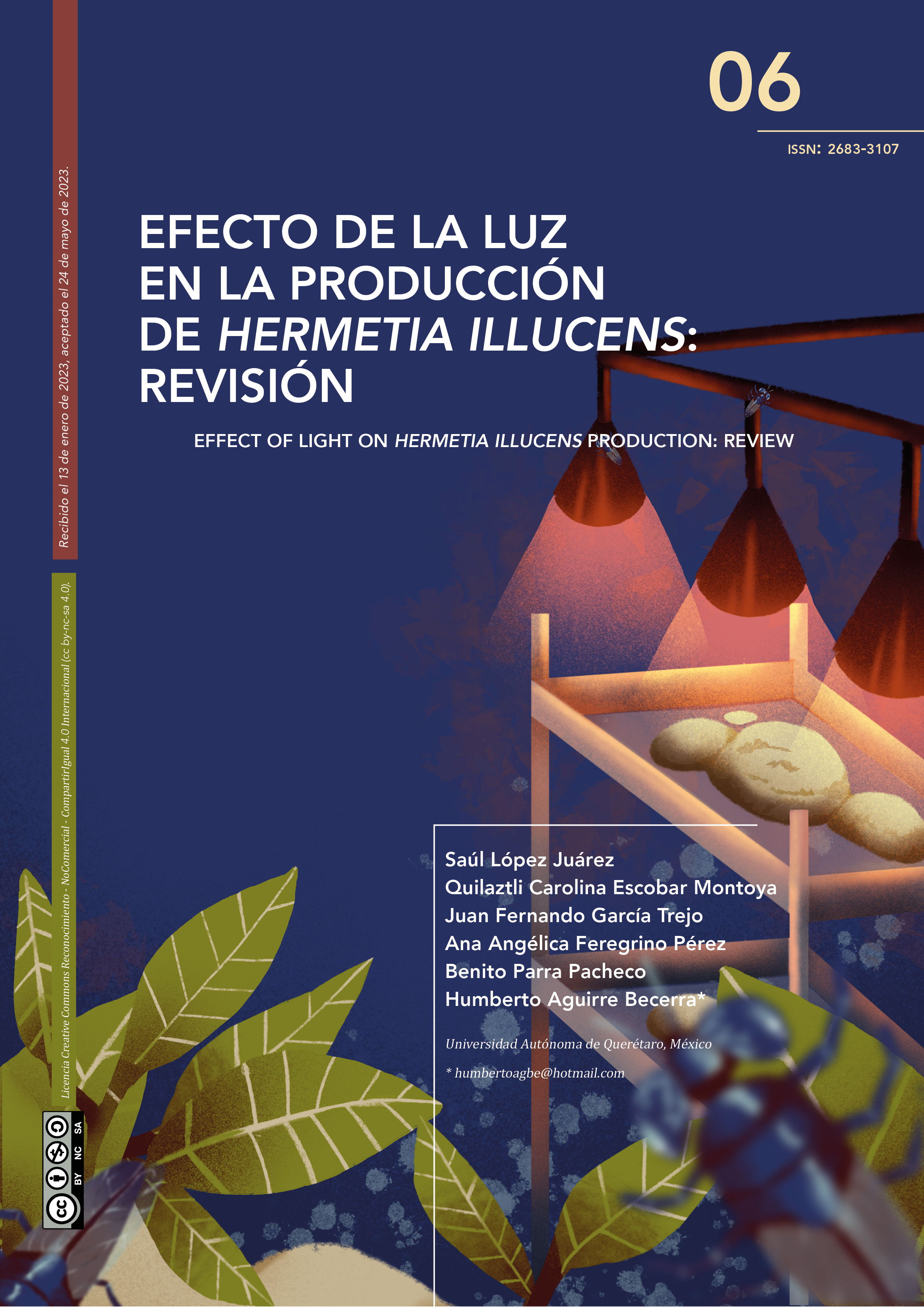Abstract
The black soldier fly has become an organism of commercial interest due to its ability to transform organic waste into other compounds that can be integrated into other production chains in accordance with new circular economy trends. Currently, this organism is produced under natural light conditions, in indoor or greenhouse rearing. However, the variation in the length of the day throughout the year, or the low availability of natural light, causes low yields in egg production, resulting in a decrease in mating and fertility, making it necessary to use complementary artificial light sources. The application of different lighting systems in indoor production systems has shown that the modification of light characteristics, such as intensity, photoperiod, and electromagnetic spectrum, have effects on the life span of adult flies, oviposition time, number of postures, fertility, fecundity, among others. The application of artificial light sources in indoor production systems in isolation and complementary with natural light could result in an increase in soldier fly larvae production, mainly derived from an increase in egg production. Therefore, this review article aims to compile information on articles that conducted studies on the application of lighting systems in the production of black soldier fly and to establish the basis for the selection of an appropriate light source for the cultivation of this organism.
References
T. R. Green, R. Popa, “Enhanced ammonia content in compost leachate processed by black soldier fly larvae,” Applied biochemistry and biotechnology., vol. 166, pp. 1381-1387, 2012.
C.H. Lalander, J. Fidjeland, S. Diener, S. Eriksson, “Vinneras, B. High waste-to-biomass conversion and efficient Salmonella spp. Reduction using black soldier fly for waste recycling,”. Agron. Sustain. Dev., vol 35, pp. 261–271, 2015.
Y.S Wang, and M. Shelomi, “Review of black soldier fly (Hermetia illucens) as animal feed and human food,” Foods., vol. 6, pp. 91, 2017.
J. De Smet, E. Wynants, P. Cos, L. Van Campenhout, “Microbial community dynamics during rearing of black soldier fly larvae (Hermetia illucens) and impact on exploitation potential,” Applied and Environmental Microbiology., vol. 84, 2018.
A. C. Samayoa, S. Y. Hwang, “Degradation capacity and diapause effects on oviposition of Hermetia illucens (Diptera: Stratiomyidae),” Journal of economic entomology., vol. 111, no. 4, pp. 1682-1690, 2018.
J.K. Tomberlin, P.H. Adler, H.M. Myers, “Development of the black soldier fly (Diptera: Stratiomyidae) in relation to temperature,” Environmental entomology., vol. 38, pp. 930–934, 2009.
J.K. Tomberlin, D.C. Sheppard, “Factors Influencing Mating and Oviposition of Black Soldier Flies (Diptera: Stratiomyidae) in a Colony,” J Entomol Sci., vo1. 37, pp. 345, Oct. 2002.
J. Zhang, L. Huang, J. He, J.K. Tomberlin, J. Li, C. Lei, “An artificial light source influences mating and oviposition of black soldier flies, Hermetia illucens,”. J Insect Sci., vol.3, Dec. 2010.
U. Julita, L. L. Fitri, R. E.Putra, and A.D. Permana, “Mating Success and Reproductive Behavior of Black Soldier Fly Hermetia illucens L.(Diptera, Stratiomyidae) in Tropics,” Journal of Entomology., vol. 17, pp. 117-127, 2020.
D.G. Oonincx, N. Volk, J.J.E. Diehl, J.J.A. Van Loon, and G. Belušič, ”Photoreceptor spectral sensitivity of the compound eyes of black soldier fly (Hermetia illucens) informing the design of LEDbased illumination to enhance indoor reproduction,” Journal of insect physiology., vol. 95, pp. 133-139, 2016.
C.D. Heussler, A. Walter, H. Oberkofler, H. Insam, W. Arthofer, B.C. Schlick-Steiner, and F.M. Steiner, F. M., “Influence of three artificial light sources on oviposition and half-life of the Black Soldier Fly, Hermetia illucens (Diptera: Stratiomyidae): Improving small-scale indoor rearing,” PLoS One., vol. 13, no. 5, 2018.
J.C. Schneider, “Effects of light intensity on mating of the black soldier fly (Hermetia illucens, Diptera: Stratiomyidae),” Journal of Insects as Food and Feed, vol. 6, pp. 111-119, 2020.
J.A. Girao-Goris, A. Olmedo-Salas, E. Ferrer-Fernández, “El artículo de revision,”. Revista Iberoamericana de Enfermería Comunitaria, Jul. 2007.
C. G. H. Steel, and X. Vafopoulou, “Circadian orchestration of developmental hormones in the insect, Rhodnius prolixus,” Comparative Biochemistry and Physiology A: Molecular and Integrative Physiology., vol. 144, pp. 351–364, 2006.
S. Nakamura, R. T. Ichiki, M. Shimoda, S. Morioka, “Small-scale rearing of the black soldier fly, Hermetia illucens (Diptera: Stratiomyidae), in the laboratory: low-cost and year-round rearing,” Applied entomology and zoology., vol. 51, pp. 161-166, 2016.
C. J. Van Der Kooi, D.G. Stavenga, K. Arikawa, G. Belušič, A. Kelber, “Evolution of insect color vision: from spectral sensitivity to visual ecology,” Annual Review of Entomology., vol. 66, pp. 435-461, 2021.
P. Klüber, D. Bakonyi, H. Zorn, and M. Rühl, “Does light color temperature influence aspects of oviposition by the black soldier fly (Diptera: Stratiomyidae)?,” Journal of Economic Entomology., vol. 113, no.5, pp. 2549-2552, 2020.
(2023) Time and date. [Online]. Available: https://www.timeanddate.com/sun/mexico
D.A. Hahn, and D.L. Denlinger, “Meeting the energetic demands of insect diapause: nutrient storage and utilization,” J. Insect Physiol., vol. 53, pp. 760-773, 2007.
K. Tougeron, “Diapause research in insects: historical review and recent work perspectives,” Entomologia Experimentalis et Applicata., vol. 167, pp. 27-36, 2019.
L. Ferdousi, and N. Sultana, “Impact of daylight duration on pupation and adult emergence of black soldier fly (Hermetia Illucens),” IJER., vol. 6, no. 1, pp. 142-145, Feb 2021.
L.A. Holmes, S. L. VanLaerhoven, and J. K. Tomberlin, “Lower temperature threshold of black soldier fly (Diptera: Stratiomyidae) development,” J. Insects Food Feed., vol. 2, pp. 255–262, 2016.
B. Hoc, G. Noël, J. Carpentier, F. Francis, and R. Caparros-Megido, “Optimization of black soldier fly (Hermetia illucens) artificial reproduction,” PloS one., vol. 14, no. 4, 2019.
M. Y. Abduh, M.P. Perdana, M. A. Bara, L. W. Anggraeni, and R. E. Putra, “Effects of aeration rate and feed on growth, productivity and nutrient composition of black soldier fly (Hermetia illucens L.) larvae,” Journal of Asia-Pacific Entomology., vol. 25, no. 2. 2022.
U. Julita, L.L. Fitri, R. E. Putra and A. D. Permana, “Research article ovitrap preference in the black soldier fly, Hermetia illucens (L.) (Diptera: Stratiomyidae),” J. Biol. Sci., vol. 24, pp. 562-570, 2021.

This work is licensed under a Creative Commons Attribution-NonCommercial-ShareAlike 4.0 International License.
Copyright (c) 2024 Perspectivas de la Ciencia y la Tecnología

